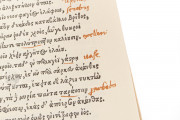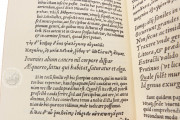Combining a translation in Latin hexameter with the original Greek text in verse, also hexameters, this bilingual and annotated version of Theriaca (Antidotes) of the ancient Greek author Nicander of Colophon was published in 1552 by the Flemish printer Juan Mey in Valencia and embellished with woodcut initials.
Nicander of Colophon was a prolific writer who lived in the second century BCE. Despite the long list of his works cited by classical authors such as Ovid, Cicero, and Pliny, the Theriaca is one of only two of his substantial works that have survived.
A Useful Text
Nicander's pharmacological text focuses on the remedies for the bites and stings of snakes, scorpions, and insects and was commonly combined with his Alexipharmaca, which addresses plant and mineral poisons. In addition to describing the composition of these poisons and their symptoms, these didactic poems helpfully detailed specific remedies for each. Nicander’s works were transmitted in numerous manuscripts and early printed editions, testifying to the high regard in which they were held in the early modern period.
The text is noteworthy for its descriptions of several varieties of cobras, as well as the black widow spider and the wind scorpion (also known as the sun spider or camel spider). In principle, Nicander's text is devoted to poisonous creatures, but the bites of many creatures he describes, including the wind scorpion, are not poisonous.
Greek Texts and Spanish Humanism
Pedro Jaime Esteve, who fashioned the Latin translation and provided the commentary, was a professor at the University of Valencia, teaching medicine and mathematics. He dedicated his translation to Bernardo Simón, a leading citizen of Valencia.
Esteve's translation was one of several scholarly inquests into classical Greek texts in the fifteenth and sixteenth centuries. His translation was the third Latin rendering of the Theriaca, and the second in hexameter, but it was the first that was made entirely from the Greek text.
The edition printed in Valencia presents passages from the Greek poem followed by the Latin verse translation printed in italic font. Esteve's prose commentary is printed in smaller italics.
A Flemish Printer in Spain
Juan (Johannes) Mey, who is identified as Flemish on the title page of the book, made his career as a printer in Spain for more than twenty years. He worked mostly, but not exclusively, in Valencia printing and editing a wide range of classical, medieval, and contemporary texts. The copy of the bilingual Theriaca in the Biblioteca Historicomédica in Valencia shows that an early owner rigorously engaged with the book, having made a series of annotations.
We have 1 facsimile edition of the manuscript "Theriaca": Nicandri Colophoni (Theriaca) facsimile edition, published by Vicent Garcia Editores, 1999
Request Info / Price












